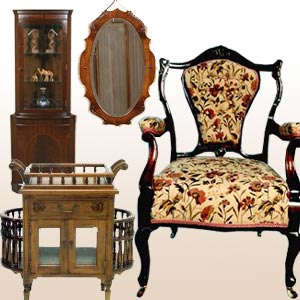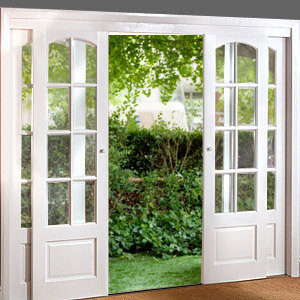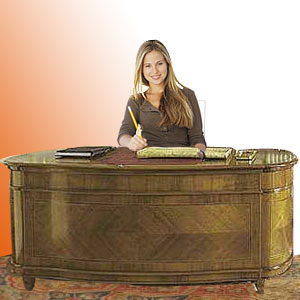Antique Furniture

'A piece of furniture that possess a beauty and quality that transcends the bounds of the era or even the field of art is represents' qualifies for masterpiece status of antique furniture according to the furniture expert Lyn Sack Wall.
Antique furniture simply does not mean old furniture but furniture of high quality and artistic merit that has transcended the bounds of time. Antique furniture is impeccably handmade by skilled craftsmen. A number of these fabulous creations are even signed by the makers. Antique furniture is auctioned in high-end houses like Sotheby. One such instance is the sale of a single mahogany secretary bookcase made by Christopher Townsend in 1740 for a whooping $ 8.25 million.
Period antique furniture
Period antique furniture refers to those made from mid to late 1600s through the first half of the 19th century. Many periods of antique furniture overlap in-between. It can be seen that every subsequent period was influenced by the style of its predecessors. The age of the antique can be determined by looking at the way the furniture is styled.
The Colonial period
- Colonial and Jacobean 1620 – 1720
- Queen Anne: 1720 -1750
- Chippendale: 1750 -1780
The Federal period
- Hepplewhite: 1780 – 1800
- Sheraton: 1790 – 1810
- Classical: 1810 – 1820
Historical records reveal that the Goddard Townsend family of Newport in Rhode Island produced some of the most valuable pieces of furniture made during this period. These styles are the epitome of the American furniture design and have been copied through the decades.
Windsor: Another antique furniture style is Windsor. This style does not fall under any specific time frame. The period is normally assigned to the later half of the 18th century. It is said that Windsor pieces are oft-imitated styles. A curator should be able to examine closely with an eye for quality to determine exactly when the pieces were produced.
Depression Era Furniture: Depression era pieces dates back to the 20s, 30s and early 1940s. Though technically these are not antiques, as they are not more than 100 years old yet, they can be regarded as ‘antique’ as they are popular with collectors and decorators and are offered for sale at steep prices.
Some furniture pieces belonging to the Depression Era are immensely popular. China and curio cabinets with curved fronts and glass panels, dressing tables with benches and side mirrors that can be adjusted to show the face, profile and back of the hair and small tables with fancy inlays and veneers command highest prices. The disadvantage of depression Era furniture is that they are larger than today’s pieces and occupy a lot of space in the home.
Characteristic features of antique furniture
Antique furniture categories vary from wood and types of materials used, methods of construction and style of decoration.
Woods used in antique furniture: Most antique furniture is made of solid wood. Over periods of time, the technique of decorating the furniture by applying veneers developed. This afforded the use of thin sheets of expensive woods and allowed the maker to create decorative effects from using different grains and patterns called ‘figuring’ of the wood. In veneered furniture, the body is solid and made of less expensive wood such as pine or oak. Some of the most frequently used types of wood in antique furniture are discussed below:
- Beech: This is a type of brownish white wood used in the 17th century. They were popularly used in frames of upholstered furniture. Beech is very strong and does not split when tacked. Beech was also used as a base for painted furniture in the 18th and 19th centuries.
- Cherry: American Queen Anne and Chippendale furniture were made of this orange brown wood usually used in solid furniture styles.
- Amboyna: This is a richly colored wood with tight grain. Increasingly used in the 18th century furniture and Regency periods.
- Chestnut: Used during the 18th century, this wood with tones from light to dark brown was popular with French provincial furniture.
- Ebony: Often used in contrasting inlay work in veneering, this is a dense and heavy almost black wood.
- Caoromandel: This was used mainly in the Regency period for refined furniture works.
- Mahogany: Immensely popular in England during the 1730s, Mahogany are a golden brown or red brown wood and the most common being Honduras and Spanish origins.
- Elm is popular wood for Windsor chairs and provincial English Furniture.
- Oak: Rich chocolate brown in color and coarse grained, this is the wood used predominantly in Britain and Middle Ages to late 17th century.
- Pine: Honey colored wood used in England and America as secondary timber for drawing linings. In 19th century this inexpensive pine was used for furniture which was painted.
- Rosewood: Popular with the Regency and Victorian periods in England, Rosewood is used for high quality furniture. It is dark red brown wood with blackish streaks.
- Satinwood: This is West Indian wood lightly yellow colored and used favorably in the 19th century. This wood is expensive and used for embellishment with painted decorations. This wood was popular during the Edwardian period.
- Virginia walnut is a rich colored and wood resembling mahogany used in English and American furniture from 1730s.
- Walnut is honey brown colored and used in English furniture from 1660 to 1690s. Walnut is also popular in America and in the Victorian era.
- Yew: This is a red brown hardwood used in veneers and in English Provincial furniture of the 17th and 18th centuries.
Color of antique furniture
One important aspect that an antique collector of furniture should know is the fact that furniture attains a rich mellow color over the years from an accumulation of wax polish and dirt. Most of the furniture is not the same color all over as the grooves and carving tend to look darker. The surfaces that are exposed to the sunlight may become lighter.
Feature of antique furniture
- Early antique furniture was made of mortice and tenon joints. Pegs were handmade and they held the furniture instead of the screws. This was the method of construction used till the end of 17th century.
- In the later years, machine-made pegs which were perfectly symmetrical were being used.
- During the 18th century, the joints were dovetailed and glued instead of screws.
- One could notice straight saw marks in the furniture made before the end of 18th century, when the ‘saw’ was not invented. It was only after 1800 that the circular marks are visible on the furniture as the saw was being employed.
- The earlier screws that were used in furniture were crude and tend to be off center and top irregular. The screw also ran into the entire length of the shank unlike the modern screws.
- Triangular joints called ‘dovetails’ which slot together on the corners of the drawers can be seen in the antique furniture until the 18th century.
- It was only from the time of Queen Anne period that runners were placed under the drawers at the sides and the draw ran on bearers placed on the inside of the carcass.
- The style of the handles tends to change from time to time and they provide a clue to the date of the antique furniture.
- Antique pommels were hand cast and in mostly in single piece of brass.
- Most of the pommels were made of brass heads with steel shanks. The thread normally ran the whole length of the shank.
- During the 18th century, the nuts used to attach the handles were circular and slightly irregular. Modern nuts are regular and hexagonal.
- Similar to the handle, the feet of the furniture also gives a useful guide to dating. A collector can compare the wood used in the feet of the furniture with the rest of the body to decide whether the piece is original or not. However one should also be aware of the fact that centuries of standing in damp floor causes the feet to rot and may need replacement.
- Locks in antique furniture of earlier dates were made of wrought iron and iron nails were used to hold the furniture in place.
- It was from the 18th century that steel or brass were used to secure the furniture and used in screws.
- Quality of an antique piece is normally determined by its proportion. A piece which looks heavy on the top or has legs that are big made can be said to be ‘marriage’ of two or more styles of different periods.
- Smaller made antique pieces are preferred than large ones.
Style of decoration in antique furniture
Carving, veneering and inlay work were the decoration styles frequently seen in antique furniture. Carving in walnut and mahogany furniture is immensely popular in antique buys. Carving is finer and more intricate in antique furniture. Original carved decoration added to the desirability of the piece.
Veneering has important bearing on the price of the antique piece. In many veneered furniture, four pieces of wood create a pattern. Banding with strips of veneer laid around the edges of drawers was also popular then. Inlay or marquetry refers to pattern made of veneers with differently colored woods. English and Continental furniture from the 17th century had inlay works on them and these add greatly to the value of the piece.
Caring for antique furniture
The beauty of antique furniture that has been cleaned and waxed simply goes to reflect the loving care bestowed on it by its owners over the years. Antique furniture deserves to be maintained in the best possible conditions. It is regular care and maintenance that will give years of life to the antique furniture and satisfaction to the collector.
- Never use spray furniture cleaning products on antique furniture. They leave oily residue on the furniture.
- It is recommended not to use anything with a rough texture on the antique furniture. This could scratch the furniture and mar the surface.
- Remember to dust the antique piece regularly and entirely.
- The patina of antique furniture has to be nurtured as it is very special.
- Always a good quality paste wax should be used on antiques, though higher priced. The wax should be applied little by little following the grain of the wood and giving it a layered finish.
- Only very soft cloth such as cheesecloth should be used for waxing. Never overdo the waxing. A thin even coat of polish can be gently rubbed in for high polish.
- In antique furniture when a piece of veneer or inlay comes loose, it is best to preserve it. This is because of the fact that substitutes are impossible to find for antique pieces and they are irreplaceable. It is also not recommended for the layman to glue them back and repair without seeking professional advice.
- It is strongly advised not to use the regular metal cleaning polish for the metal ornamentation or hardware such as brass knobs or keyholes and other decorations found in antique furniture. By polishing the metal there are chances for the wood underneath to get damaged.
- A great deal of surface damage can be prevented in antique furniture if one remembers to use coasters, mats and trivets. Avoid placing hot and wet items directly on the furniture.
- Wood responds to changes in temperature and humidity. It swells or shrinks and can warp or split. So it is better to avoid extremes of temperature and make sure that wooden antique objects are not dried out or become too damp.
- It is always better to call a furniture expert in antiques if there are spills, stains or scratches in the furniture.
Tips on buying antique furniture
Antique furniture no doubt adds to the style and grace of carefully maintained interiors of a home décor. There are certain basic factors that need to be considered before choosing / buying an antique masterpiece:
- An ornate Victorian piece will definitely be out of place in a modern and minimal designed home.
- Functional and attractive antique furniture such as chairs, cabinets, desks and dressing tables are often a good buy.
- Antique furniture styles should be incorporated throughout the home. A living space of a house is enhanced by placing an elaborately gilded mirror in the foyer or a hand planed bench in the kitchen.
- For those who want to have the antique look in furniture but are unable to spend, ‘reproduction furniture’ is available.
- Many collectors prefer specific eras, styles and makers while there are others with more eclectic tastes. The value of an authentic piece of furniture is influenced by its condition, rarity and history.
- A buyer also needs to consider the size and weight of each antique furniture piece. A heavy antique piece not only makes transportation difficult but is expensive as well. Another aspect is that heavy furniture may not vibe well with medium and other light furniture in the premises.
Top of the Page: Antique Furniture
Tags:#antique furniture
 Home and Garden
Home and Garden Home Improvement Tips
Wood Furnace
Hardwood Floor
Bamboo Flooring
DIY Damp Proofing
Home Improvement Contractor
Handyman Services
House Painting Tip
Faux Painting
Exterior Wall Cladding
Elastomeric Paint
Waterproofing
Home Decor
Christmas Yard Decorations
Sliding French Door
Home Furnishing Idea
Vinyl Siding
Upgrade House Siding
Driveway Resurfacing
Closet Organizer
Linen Cabinet
Blown Glass Vase
Contemporary Credenza
Fish Tank Aquarium
Thanksgiving Cactus
Home Garden Design
Backyard Playhouse
Dining Room Design
Silk Floral Arrangement
Laundry Hamper
Antique Glassware
Fireplace Mantel
Indoor Fountain
Ceiling Texture
Recycling Facts
Cleaning
 Seasonal Home Maintenance Checklist
Seasonal Home Maintenance Checklist Cleaning Bathroom Tile Grout
Spring Cleaning Tips
Stain Removal
Odor Eliminator
Kitchen Garbage Disposal
How to Declutter
Windows
 French Window
French Window Casement Window
Bay Window
Replace Home Window
Retractable Awning
Curtain Valance
Silk Curtains
Lightings
Wrought iron chandeliers
Hybrid Solar Lighting
Motion Sensor Outdoor Lighting
Lamp Shade
Home Lighting Fixture
Chandelier Lighting
Foyer Lighting
Recessed Lighting Fixtures
Home Security
Burglar Alarm System
Video Surveillance Camera
Web Security Cameras
Security cameras
CCTV Cameras
Driveway Alarm
Home Electronics
 Windows 10 Tips for Power Users
Windows 10 Tips for Power UsersSmart Home Tips
Patio Radiant Heaters
Solar Water Heater Systems
Driveway Gates
Vacuum Cleaner Review
Dehumidifier
Clothes Dryer
Integrated Dishwasher
RFID Technology - RFID Application
Lower Energy Bills
Reduce Carbon Footprint
Electronic Pest Control
Home Appliance Maintenance
 Washing Machine Maintenance
Washing Machine Maintenance Ionizer Air Purifier
Vacuum Cleaner Maintenance
Appliance Maintenance - Refrigerator
Dishwasher Maintenance
Do it yourself Home Improvement
Kitchen Appliances
Budget Kitchen Upgrade
Food Steamer
Waffle Iron
Garment Steamer
Crepe Maker
Kitchen Blender
Meat Grinder
Juicer
Gas Grill
Barbecue Smoker
Kitchen Improvement
 Types of Cutlery
Types of Cutlery New Kitchen Countertops
Kitchen Cabinet
Kitchen Chimney Hoods
Kitchen Pantry
Kitchen Knife
Metal Bread Box
Kitchen Canister
Kitchen Remodeling Idea
Kitchen Furniture
Kitchen Faucet
Kitchen Lighting Idea
Custom Kitchen Island
Ceramic Kitchen Sink
Kitchen Backsplash Tile
Crockery
Barbecue Grilling Tip
Stainless Steel Tableware
Bath
Bathroom Sink Vanity
Shower Enclosures Kits
Shower Massage Panel
Bath Safety for Seniors
Inground Swimming Pool
Swimming Pool Maintenance
Replacing Bathroom Fixtures
Remodel Bathroom
Bath Tub Restoration
Jacuzzi Tub
Bedding
Organic Mattress
Memory Foam Mattress
Water Bed Mattress
Childrens Bunk Beds
Adjustable Bed
Neck Pillow
Luxury Bed linen
Furnitures
 Writing Desk
Writing Desk Bedroom Furniture
Furniture Restoration
Bar Stool
Antique Furniture
Bedside Table Design
Picnic Table
Storage Ottoman
Kitchen Buffet Furniture
Contemporary Furniture Guide
Rustic Furniture
Space Saving Furniture
Wood Furniture Care
Top of the Page: Antique Furniture
Popularity Index: 101,467

